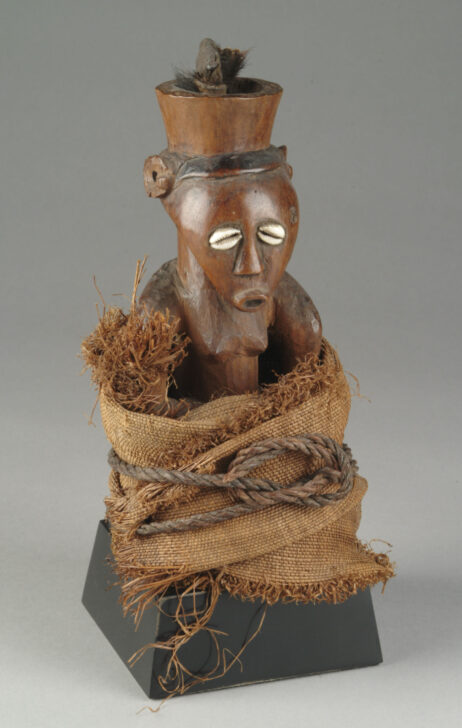Power Figure
Kusu

Description
Subject Matter:
This power figure, or kakudji, is attributed to the Kusu from the Democratic Republic of the Congo. The term kakudji refers to a vast genre of visual forms that are seen as receptacles or vessels of spirit beings; these forms can vary from being janus-faced, attached to a calabash, or carried as a portable amulet.
Spiritual mediums prescribed and consecrated specific kakudji to meet the particular needs of the owner and his family, including healing of the ill or infertile and ensuring success and safety in hunting. In this way, kakudji acted as visual reminders to the community that their deceased ancestors were continually protecting and assisting them. Kept privately in the home and safeguarded by the head of the family, the figures were passed down from father to son and could last for several generations.
This particular kakudji is emblematic of the Kasongo style of Kusu woodcarving, known for being most representative of what can be considered a “classical” or “pure” Kusu stylistic form. Its large belly suggests pregnancy and therefore evokes maternity, fecundity, procreation, and the continuation of the family line. Also notable is the bowl-like container resting on top of the female’s head; this vessel was intended to carry ingredients specially crafted by the medium to activate and energize the spirit within. The crown of the head, and to be more precise, the fontanelle, is regarded as the site of communication with spirit entities.
Reference:
Maurer, Evan M. and Niangi Batulukisi. Spirits Embodied: Art of the Congo, Selections from the Helmut F. Stern Collection. Minneapolis: The Minneapolis Institute of Arts, 1999.
Physical Description:
This woodcarved figure depicts a female with a large bowl-shaped vessel upon the crown of her head, intended to be a container for symbolic, medicinal and spirit “activating” ingredients. Representative of the Kasongo style (regarded as the “classical” or “pure” Kusu stylistic form), this kakudji features an inverted, triangular-shaped head, a wide, convex forehead, high ears, cowrie shell eyes, a triangular nose, an oval mouth with protruding lips, a pointed chin, and conical breasts. The figure possesses a prominent belly indicating pregnancy, and representing the themes of maternity, fertility, and the continuation of the lineage. A large piece of textured cloth tied in place with rope encircles the female’s lower arms and lower body.
Usage Rights:
If you are interested in using an image for a publication, please visit https://umma.umich.edu/request-image/ for more information and to fill out the online Image Rights and Reproductions Request Form.